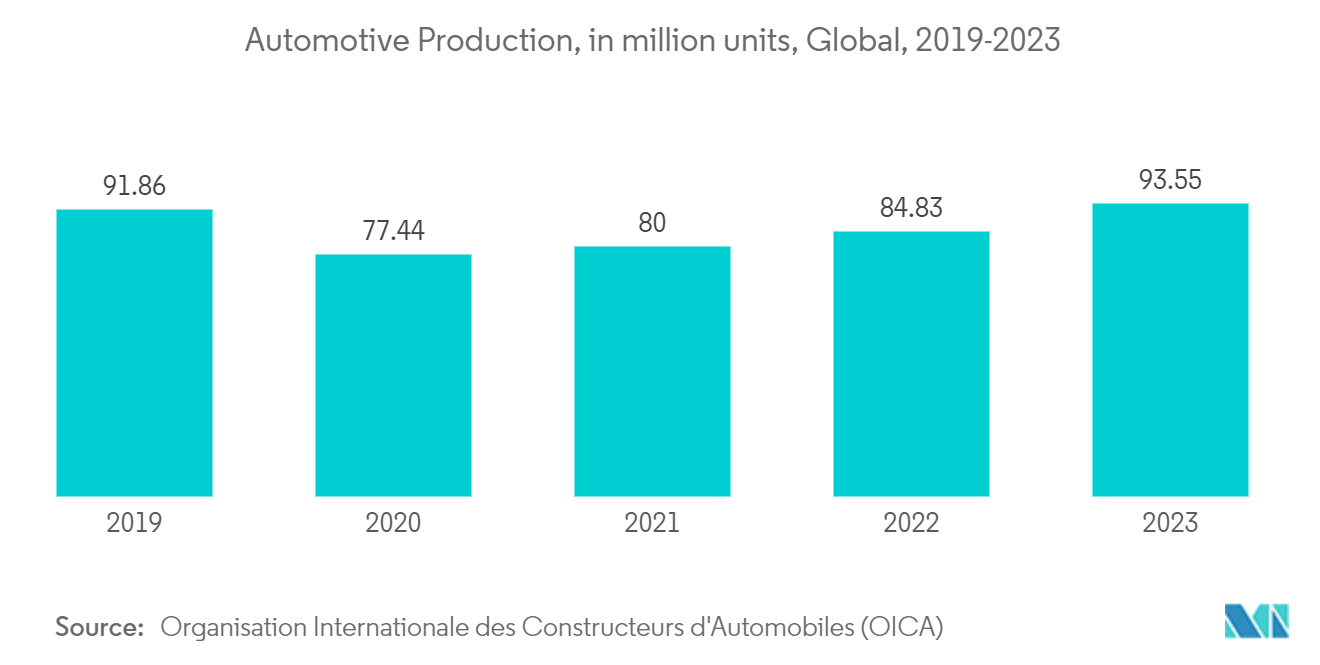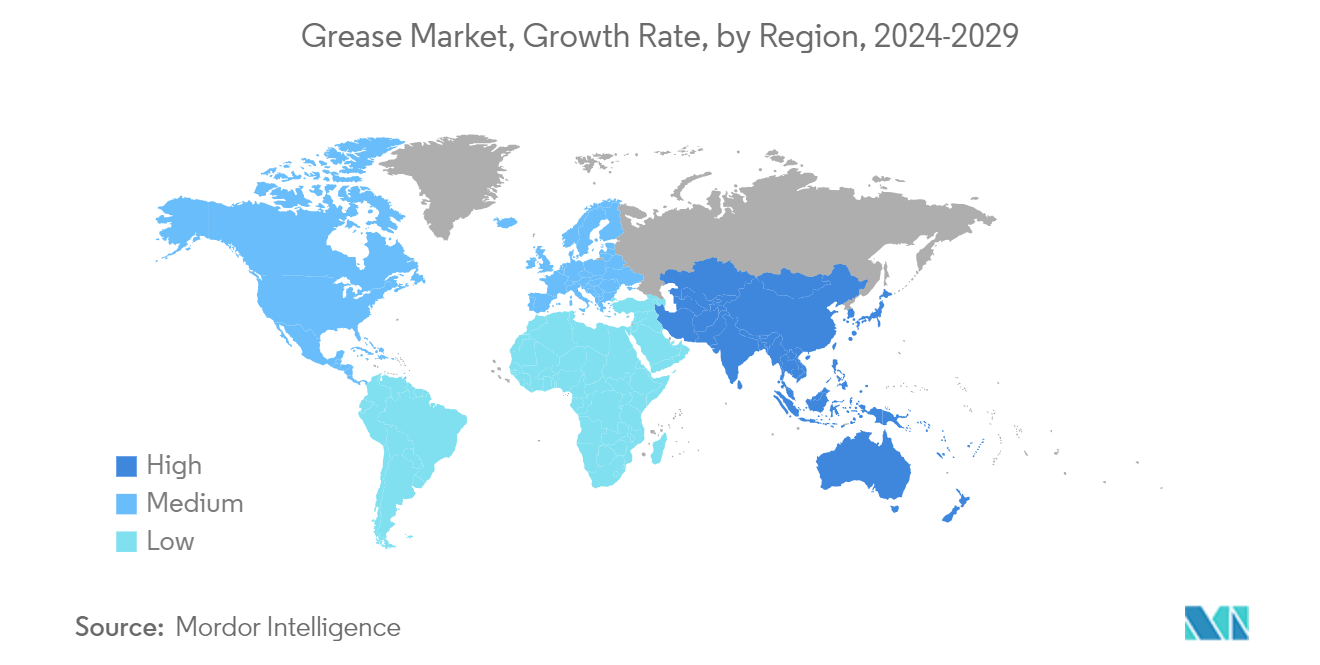Market Trends of Grease Industry
Automotive and Other Transportation Segment to Dominate the Market
- The automotive and transportation sector plays a pivotal role in driving the grease market. As the OEM and RMO markets in the automotive industry expand, they are poised to directly influence grease demand in the coming years.
- The major reasons for the high demand for grease are the growing demand for lightweight, high-performance cars in emerging markets, increasing automotive hubs, and rising disposable income.
- In 2023, global new vehicle sales saw a robust growth of 11.9% over 2022, totaling over 92.7 million units, as reported by the Organisation Internationale des Constructeurs d'Automobiles (OICA). Specifically, new passenger vehicle sales climbed by 11.3% year-over-year, hitting 65.3 million units, up from 58.6 million units in 2022. Concurrently, new commercial vehicle registrations worldwide rose to 27.5 million units in 2023, marking a notable 13.3% increase from the 24.2 million units recorded in 2022.
- In North America, motor vehicle sales in 2023 accounted for 19.19 million units, an increase of 13.4% compared to 16.93 million units sold in 2022. Out of the total 19.19 million units, passenger cars accounted for 3.98 million units, commercial vehicles made up 15.21 million units, and the remaining units were a combination of heavy trucks, buses, and coaches.
- Furthermore, as per the data from the European Automobile Manufacturers Association, in Europe, the overall registration of new motor vehicles increased by 18.7% in 2023 compared to the previous year. In 2023, passenger car and commercial vehicle sales reached 15 million units and 2.90 million units, respectively, compared to 12.64 million units and 2.44 million units in 2022.
- The aerospace sector is witnessing swift technological advancements, bolstering aircraft manufacturing. Boeing's Commercial Outlook for 2023-2042 anticipates global demand for 48,575 new commercial jets by 2042, driven by a rebound in international and domestic air travel. In 2023, Boeing delivered 528 aircraft and secured 1,314 net new orders, a significant rise from 480 deliveries and 774 orders in 2022. Notably, while it met its revised goal of delivering at least 375 narrowbody 737 jets, it fell short of its initial target of 400 to 450 jets.
- As per the data provided by Airbus, in 2023, the company delivered 735 commercial aircraft to 87 customers around the world, demonstrating strong performance despite a complex operating environment. The company’s “Commercial Aircraft” business registered 2,319 gross new orders during the same year.
- Given these dynamics, grease consumption is set to rise in the coming years.

Asia-Pacific to Dominate the Market
- Asia-Pacific leads in grease consumption, with North America and Europe following. Countries like China, India, and Indonesia are poised to drive strong grease demand during the forecast period.
- Currently, China stands as the dominant consumer of lubricants and greases. Its extensive manufacturing activities across various sectors, coupled with rapid growth in both industrial and automotive domains, have solidified its position as a major global consumer and producer of grease.
- Some of the key grease manufacturers are actively pursuing expansion strategies, eyeing entry into new markets, thereby augmenting the demand for the market studied. For instance,
- In June 2024, Shell completed a significant expansion at its grease manufacturing plant in Bangkok, tripling its production capacity. This enhancement positions the plant to meet half of Thailand's grease demand, boosting its annual output from 5,000 to 15,000 metric tons.
- Shell Indonesia unveiled plans in March 2024 to construct its inaugural Grease Manufacturing Plant (GMP) in Bekasi, Indonesia, with a capacity of 12 kilotonnes per annum. This facility will complement the company's existing Marunda Lubricants Oil Blending Plant (LOBP).
- China's automotive industry stands out as the leading consumer of lubricants, reflecting its robust vehicle fleet growth and technological advancements. In 2023, both automobile sales and production in China reached a milestone, hitting 30 million units each, marking a double-digit increase from the previous year, as per the data from the China Association of Automobile Manufacturers (CAAM).
- The demand for grease in China's power generation sector is likely to perform well during the forecast period. According to reports by Ember, a community interest company, the country's power generation industry is growing rapidly and may register over 10% growth in the near future.
- China's electricity demand rose by over 4% in 2023 and by over 3% in 2022. There are 47 nuclear power stations in service in China, with a total installed capacity of 48.76 GW. A total of 11 new nuclear power plants with an installed capacity of 11.759 GW were being built.
- In 2023, India's passenger vehicle sales crossed the 4 million mark for the first time, driven by rising incomes, a surge in sport-utility vehicles, and favorable loan rates. As per the data from the Society of Indian Automobile Manufacturers (SIAM), over 4.1 million cars, sedans, and utility vehicles were sold, marking an 8.2% uptick from 3.79 million units in 2022, with utility vehicles making up 57.4% of the sales.
- Indonesia's power generation sector is in a state of evolution, spurred by escalating energy demands and ambitious sustainability aspirations. While coal currently dominates, accounting for over 60% of the electricity supply, there is a determined effort to diversify and amplify the role of renewables. With a hydropower potential nearing 75 GW, projects like the 1,040 MW facility in West Java are already capitalizing on this resource. Geothermal energy targets stand at 5 GW by 2025, with an ambitious leap to 9.3 GW by 2035, underscoring the nation's commitment to harnessing its vast renewable energy potential.
- The above-mentioned factors are likely to increase the demand for grease in Asia-Pacific.


